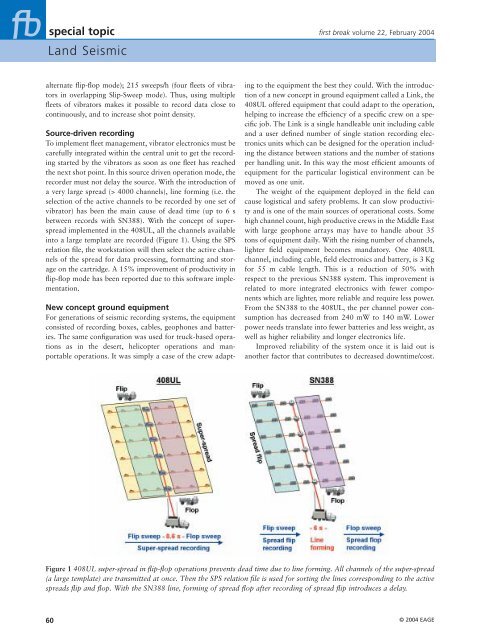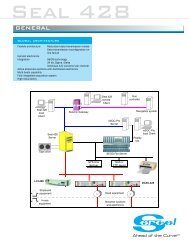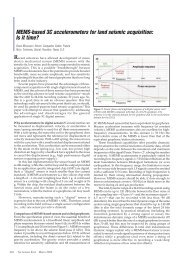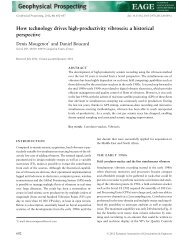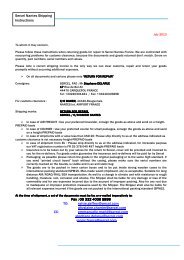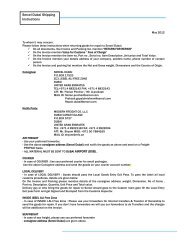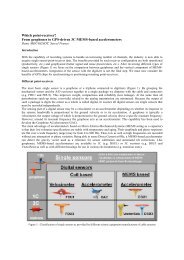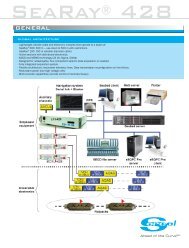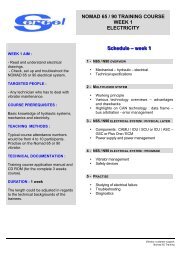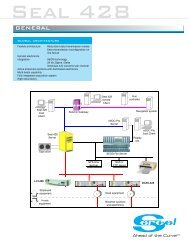Land seismic - Sercel
Land seismic - Sercel
Land seismic - Sercel
Create successful ePaper yourself
Turn your PDF publications into a flip-book with our unique Google optimized e-Paper software.
special topic<br />
<strong>Land</strong> Seismic<br />
first break volume 22, February 2004<br />
alternate flip-flop mode); 215 sweeps/h (four fleets of vibrators<br />
in overlapping Slip-Sweep mode). Thus, using multiple<br />
fleets of vibrators makes it possible to record data close to<br />
continuously, and to increase shot point density.<br />
Source-driven recording<br />
To implement fleet management, vibrator electronics must be<br />
carefully integrated within the central unit to get the recording<br />
started by the vibrators as soon as one fleet has reached<br />
the next shot point. In this source driven operation mode, the<br />
recorder must not delay the source. With the introduction of<br />
a very large spread (> 4000 channels), line forming (i.e. the<br />
selection of the active channels to be recorded by one set of<br />
vibrator) has been the main cause of dead time (up to 6 s<br />
between records with SN388). With the concept of superspread<br />
implemented in the 408UL, all the channels available<br />
into a large template are recorded (Figure 1). Using the SPS<br />
relation file, the workstation will then select the active channels<br />
of the spread for data processing, formatting and storage<br />
on the cartridge. A 15% improvement of productivity in<br />
flip-flop mode has been reported due to this software implementation.<br />
New concept ground equipment<br />
For generations of <strong>seismic</strong> recording systems, the equipment<br />
consisted of recording boxes, cables, geophones and batteries.<br />
The same configuration was used for truck-based operations<br />
as in the desert, helicopter operations and manportable<br />
operations. It was simply a case of the crew adapting<br />
to the equipment the best they could. With the introduction<br />
of a new concept in ground equipment called a Link, the<br />
408UL offered equipment that could adapt to the operation,<br />
helping to increase the efficiency of a specific crew on a specific<br />
job. The Link is a single handleable unit including cable<br />
and a user defined number of single station recording electronics<br />
units which can be designed for the operation including<br />
the distance between stations and the number of stations<br />
per handling unit. In this way the most efficient amounts of<br />
equipment for the particular logistical environment can be<br />
moved as one unit.<br />
The weight of the equipment deployed in the field can<br />
cause logistical and safety problems. It can slow productivity<br />
and is one of the main sources of operational costs. Some<br />
high channel count, high productive crews in the Middle East<br />
with large geophone arrays may have to handle about 35<br />
tons of equipment daily. With the rising number of channels,<br />
lighter field equipment becomes mandatory. One 408UL<br />
channel, including cable, field electronics and battery, is 3 Kg<br />
for 55 m cable length. This is a reduction of 50% with<br />
respect to the previous SN388 system. This improvement is<br />
related to more integrated electronics with fewer components<br />
which are lighter, more reliable and require less power.<br />
From the SN388 to the 408UL, the per channel power consumption<br />
has decreased from 240 mW to 140 mW. Lower<br />
power needs translate into fewer batteries and less weight, as<br />
well as higher reliability and longer electronics life.<br />
Improved reliability of the system once it is laid out is<br />
another factor that contributes to decreased downtime/cost.<br />
Figure 1 408UL super-spread in flip-flop operations prevents dead time due to line forming. All channels of the super-spread<br />
(a large template) are transmitted at once. Then the SPS relation file is used for sorting the lines corresponding to the active<br />
spreads flip and flop. With the SN388 line, forming of spread flop after recording of spread flip introduces a delay.<br />
60<br />
© 2004 EAGE


